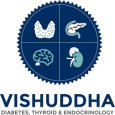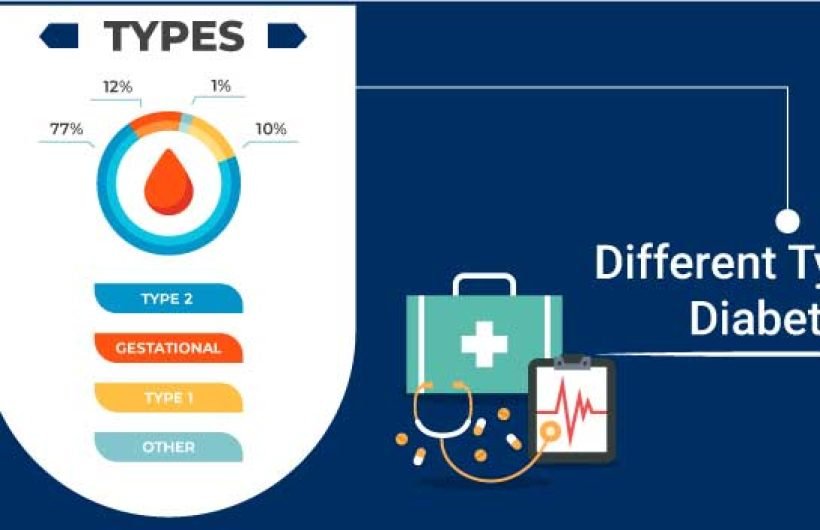Diabetes is a long-term medical illness that has an impact on how our bodies process glucose (sugar). Either the body cannot use the insulin that is generated adequately or the pancreas does not make enough of it. Insulin is a hormone that is needed to allow glucose to enter the cells of our body and produce energy. The three primary kinds of diabetes are mentioned below:
Primary Form of Diabetes
Type 1 Diabetes
The immune system targets and kills the insulin-producing beta cells in the pancreas in type 1 diabetes, an autoimmune condition. Typically, it happens in adolescence or age. People with type 1 diabetes need to take insulin every day to maintain their health. According to a research link from Diabetes UK, type 1 diabetes makes up 10% of all occurrences of diabetes.
Although the precise origin of type 1 diabetes is unknown, scientists think that environmental and genetic causes may potentially be at play. Type 1 diabetes in a close relative raises the risk. Additionally mentioned as potential triggers are viruses.
The main symptoms of type 1 diabetes are increased thirst, frequent urination, weight loss even with increased appetite, fatigue, blurry and cut eyes, and slow healing of wounds Those symptoms occur when the body tries to expel excess glucose due to insulin deficiency. Left untreated, Type 1 diabetes is caused by diabetic ketoacidosis – a potentially life-threatening condition in which harmful acids called ketones form in the blood and urine
There is currently no treatment for type 1 diabetes. People with this condition should monitor their blood glucose levels regularly and go through insulin injections or an insulin pump. A balanced diet, regular exercise, and blood glucose control are important to manage the disease. Therapeutic options such as stem cell transplantation and immunotherapy to slow or block the destruction of beta cells by the immune system are under investigation.
Type 2 Diabetes
According to Diabetes UK, type 2 diabetes accounts for 90% of all occurrences and is the most prevalent kind of the disease. In type 2 diabetes, the cells either do not respond to insulin or the body does not create enough of it. Blood sugar levels rise as a result.
Due to rising obesity rates and sedentary lifestyles, type 2 diabetes is more common in middle-aged and older adults but is also on the rise in younger people, particularly adolescents. Although genetics play a part, lifestyle variables have a significant impact on risk. The primary factors include being overweight or obese, a lack of exercise, poor nutrition, and excessive alcohol usage.
Diabetes type 2 might go undiscovered for years and typically has less symptoms than diabetes type 1. Some patients show absolutely no symptoms.
Type 2 diabetes usually has fewer symptoms than type 1 and can go unnoticed for years. Some people have no symptoms at all. Over time, elevated blood glucose levels can damage various organs, including the eyes, kidneys, nerves, and heart.
Although there is no cure for type 2 diabetes, lifestyle changes such as weight loss through diet and exercise, reducing alcohol consumption, and quitting smoking can help manage the condition. Usually, the first drug to lower blood glucose levels is metformin. If blood sugar levels are not adequately controlled by lifestyle changes alone, other oral medications and insulin injections may be necessary.
Gestational Diabetes
Gestational diabetes is a type of diabetes that develops during pregnancy and usually disappears after birth. Depending on the context, it occurs in about 2-5% of all pregnancies. Hormones during pregnancy can interfere with the action of insulin and raise blood sugar levels. It is also a family history of obesity or diabetes.
Women with gestational diabetes are at increased risk of developing type 2 diabetes later on. They should work with their doctor to monitor blood sugar levels and make appropriate lifestyle changes to reduce this risk. Gestational diabetes also increases her chances of complications, such as the need for a cesarean section. Babies are also at increased risk of developing obesity, later childhood diabetes, or pre-diabetes.
Gestational diabetes is usually tested between 24-28 weeks of pregnancy. If not properly managed with diabetes diet, exercise, and sometimes medication, preeclampsia (high blood pressure during pregnancy), and a large baby can occur proper blood sugar control and lifestyle management is important for the health of mother and baby. Blood sugar levels generally return to normal after delivery but women should still be tested periodically for diabetes.
Other Types
In addition to the three main types, there are a few other less common forms of diabetes:
Maturity-onset diabetes of the young (MODY): A rare genetic form accounting for 1-2% of all diabetes cases. It usually appears in people under 25 years of age.
Neonatal diabetes: A very rare type that develops in the first six months of life. It may be permanent or transient.
Secondary diabetes: Results from other medical conditions like pancreatic diseases or medications. It accounts for 1-5% of all diabetes cases.
Idiopathic diabetes: The cause is unknown and does not clearly fit into any other category. It is diagnosed when a person is over 30 years old.
In summary, while diabetes has some common symptoms, the specific causes and treatments vary depending on the type. Understanding the different types helps in properly diagnosing and managing the condition. With lifestyle management and medical care, people with any type of diabetes can live healthy lives. More research continues to help find better treatment and prevention strategies.
Diagnosis and Treatment
The main types of diabetes are based on symptoms, blood or urine test results to check blood glucose levels, and sometimes genetic tests Treatment depends on the type but includes lifestyle changes, medications that drinking, insulin therapy, insulin pumps, and other medical devices blood glucose levels as much as possible The goal is to keep them as close to normal.
Thanks to advances in research and treatment, many people live better with diabetes. However, it is a complex condition that requires ongoing medical attention and self-monitoring to avoid health problems down the road. Understanding the types of diabetes allows you to better understand risk factors and work closely with the healthcare team to achieve optimal health outcomes.
Conclusion
In summary, while diabetes has some common symptoms, the specific causes and treatments vary depending on the type. Understanding the different types helps in properly diagnosing and managing the condition. With lifestyle management and medical care, people with any type of diabetes can live healthy lives. If you want such adherence to treatment plans and monitoring you can contact Dr. Moxit Shah, a renowned Endocrinologist who specializes in diagnosing and treating health conditions related to body hormones and different kinds of diabetes, through which most individuals can effectively manage diabetes. More research continues to help find better treatment and prevention strategies.






